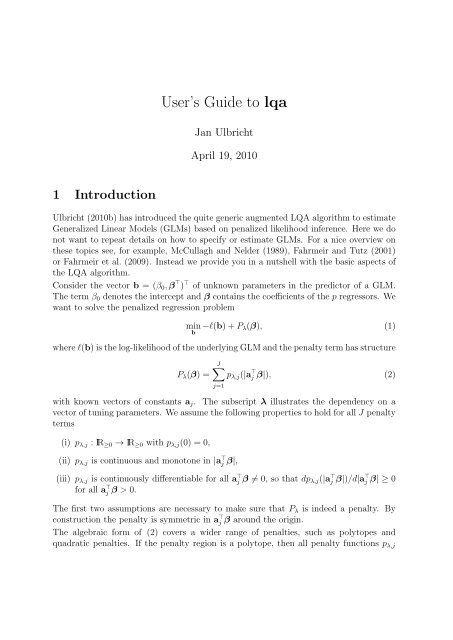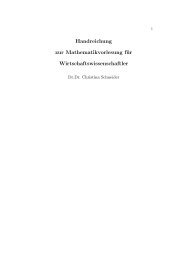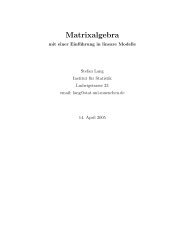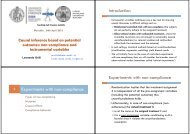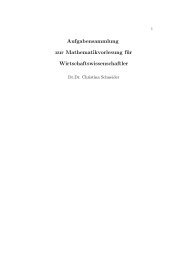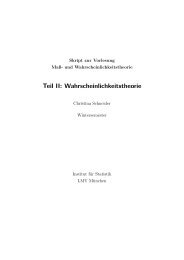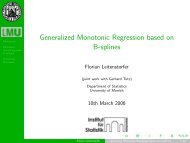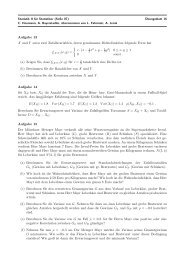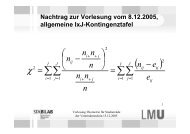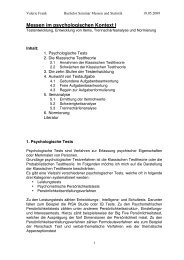You also want an ePaper? Increase the reach of your titles
YUMPU automatically turns print PDFs into web optimized ePapers that Google loves.
User’s <strong>Guide</strong> <strong>to</strong> <strong>lqa</strong><br />
Jan Ulbricht<br />
April 19, 2010<br />
1 Introduction<br />
Ulbricht (2010b) has introduced the quite generic augmented LQA algorithm <strong>to</strong> estimate<br />
Generalized Linear Models (GLMs) based on penalized likelihood inference. Here we do<br />
not want <strong>to</strong> repeat details on how <strong>to</strong> specify or estimate GLMs. For a nice overview on<br />
these <strong>to</strong>pics see, for example, McCullagh and Nelder (1989), Fahrmeir and Tutz (2001)<br />
or Fahrmeir et al. (2009). Instead we provide you in a nutshell with the basic aspects of<br />
the LQA algorithm.<br />
Consider the vec<strong>to</strong>r b = (β 0 , β ⊤ ) ⊤ of unknown parameters in the predic<strong>to</strong>r of a GLM.<br />
The term β 0 denotes the intercept and β contains the coefficients of the p regressors. We<br />
want <strong>to</strong> solve the penalized regression problem<br />
min<br />
b<br />
−l(b) + P λ (β), (1)<br />
where l(b) is the log-likelihood of the underlying GLM and the penalty term has structure<br />
P λ (β) =<br />
J∑<br />
p λ,j (|a ⊤ j β|), (2)<br />
j=1<br />
with known vec<strong>to</strong>rs of constants a j . The subscript λ illustrates the dependency on a<br />
vec<strong>to</strong>r of tuning parameters. We assume the following properties <strong>to</strong> hold for all J penalty<br />
terms<br />
(i) p λ,j : IR ≥0 → IR ≥0 with p λ,j (0) = 0,<br />
(ii) p λ,j is continuous and mono<strong>to</strong>ne in |a ⊤ j β|,<br />
(iii) p λ,j is continuously differentiable for all a ⊤ j β ≠ 0, so that dp λ,j (|a ⊤ j β|)/d|a ⊤ j β| ≥ 0<br />
for all a ⊤ j β > 0.<br />
The first two assumptions are necessary <strong>to</strong> make sure that P λ is indeed a penalty. By<br />
construction the penalty is symmetric in a ⊤ j β around the origin.<br />
The algebraic form of (2) covers a wider range of penalties, such as poly<strong>to</strong>pes and<br />
quadratic penalties. If the penalty region is a poly<strong>to</strong>pe, then all penalty functions p λ,j
2<br />
must be linear. Note that the sum of all J penalty functions determines the penalty term.<br />
The penalty level λ must not be identical for all J functions but <strong>to</strong> keep the notation<br />
simple we omit a further subindex j. Furthermore, the penalty function type must not<br />
be identical for all j. The number J of penalty functions is not necessarily equal <strong>to</strong> p the<br />
number of dimensions. For example, the fused lasso penalty (Tibshirani et al., 2005)<br />
can be written as<br />
where<br />
P fl<br />
λ (β) = λ 1<br />
P fl<br />
p∑<br />
p∑<br />
|β j | + λ 2 |β k − β k−1 |<br />
j=1<br />
k=2<br />
2p−1<br />
λ (β) = ∑<br />
p λ,j (|a ⊤ j β|), (3)<br />
j=1<br />
p λ,j (·) = λ 1 |a ⊤ j β|,<br />
j = 1, . . . , p<br />
and a j = (0, . . . , 0, 1, 0, . . . , 0) ⊤ with a one at the j-th position, and<br />
p λ,j (·) = λ 2 |a ⊤ j β|, j = p + 1, . . . , 2p − 1<br />
where a j = (0, . . . , 0, −1, 1, 0, . . . , 0) ⊤ with a one at the (j − p + 1)-th position and a<br />
minus one at the (j − p)-th position. The parameters λ 1 and λ 2 correspond <strong>to</strong> s 1 and s 2<br />
in the constrained regression problem formulation, see Tibshirani et al. (2005).<br />
Ulbricht (2010b) has shown that if the penalty term has structure (2) then the penalized<br />
regression problem (1) can be solved by a New<strong>to</strong>n-type algorithm based on local quadratic<br />
approximations of the penalty term. That is, the unknown coefficients b can be estimated<br />
iteratively with the estimation equation<br />
b (k+1) = b (k) − γ ( F(b (k) ) + A ∗ λ) −1<br />
{−s(b(k) ) + A ∗ λb (k) }, (4)<br />
where s(b) and F(b) denote score vec<strong>to</strong>r and Fisher information matrix of the underlying<br />
log-likelihood, respectively, and<br />
[ ] 0 0<br />
A ∗ ⊤<br />
λ =<br />
p<br />
,<br />
0 p A λ<br />
where 0 p is the p-dimensional null vec<strong>to</strong>r. The (approximated) penalty matrix A λ is<br />
defined as<br />
J∑ p ′ λ,j<br />
A λ =<br />
(|a⊤ j β (k) |)<br />
√ (a ) a j a ⊤ j , (5)<br />
⊤ 2<br />
j β (k) + c<br />
j=1<br />
where p ′ λ,j (|a⊤ j β (k) |) = dp λ,j (|a ⊤ j β|)/d|a ⊤ j β| denotes the first derivative with p ′ λ,j (0) ≡ 0,<br />
and c > 0 is a small positive real number. In the <strong>lqa</strong> package we will use c = 1e −6 as<br />
default value. To our experience, this value works quite well.<br />
The New<strong>to</strong>n update (4) is repeated until convergence. We apply the rule<br />
‖b (k+1) − b (k) ‖<br />
‖b (k) ‖<br />
≤ ɛ, ɛ > 0
3<br />
<strong>to</strong> terminate the algorithm. Under this criterion, the algorithm is s<strong>to</strong>pped if the relative<br />
distance moved during the k-th iteration is less or equal <strong>to</strong> ɛ. We use an additional step<br />
length parameter 0 < γ ≤ 1 <strong>to</strong> enhance convergence of the algorithm. This parameter<br />
is usually treated as fixed constant. In our experience a value γ < 1 becomes especially<br />
appropriate if the penalty term includes an L ι -norm with ι ‘large’, e.g. ι ≥ 10. Examples<br />
where this can happen are the bridge (Frank and Friedman, 1993) or the OSCAR (Bondell<br />
and Reich, 2008) penalty.<br />
In this article we will describe the R (R Development Core Team, 2009) add-on package<br />
<strong>lqa</strong>. The <strong>lqa</strong> package has been originally designed <strong>to</strong> apply the LQA algorithm (see<br />
Ulbricht, 2010b, for details) <strong>to</strong> compute the constrained MLEs of GLMs with specific<br />
penalties. In the further development the package has been extended <strong>to</strong> deal also with<br />
boosting algorithms such as componentwise boosting, GBlockBoost and ForwardBoost<br />
(Ulbricht, 2010b) which in turn are primarily intended <strong>to</strong> be used with quadratic penalties.<br />
The LQA algorithm can be viewed as an extension of the P-IRLS algorithm (see,<br />
e.g., Wood, 2006), so that the latter is also (indirectly) included.<br />
As we will see later on we use a hierarchical structure of R functions for the package<br />
that provides preparation methods (standardization, extraction of formula components<br />
etc.), the computation of important statistics (degrees of freedom, AIC, penalized Fisher<br />
information matrix etc.) and generic functions (summary, plot etc.). A convenient way<br />
<strong>to</strong> specify the details of the penalty terms is crucial for the computational application of<br />
the LQA algorithm and the boosting methods mentioned above. Therefore we start with<br />
the introduction of the penalty class in the next section. The basic structure of the <strong>lqa</strong><br />
package will be explained in Section 3, some examples for applications are illustrated in<br />
Section 4.<br />
2 The penalty class<br />
Since the <strong>lqa</strong> package focuses on shrinkage and boosting methods there will always be a<br />
penalty included in the objective function or plays a role during the inference procedure.<br />
Furthermore, we need <strong>to</strong> compute different terms corresponding <strong>to</strong> a specified penalty,<br />
such as the penalty level, or the coefficients or its gradients for the LQA algorithm. A<br />
concrete penalty consists of the penalty family and chosen tuning parameters. It will<br />
be reasonable <strong>to</strong> specify a penalty family and the tuning parameters separately. This is<br />
especially necessary for cross-validation procedures and plotting of coefficient build-ups.<br />
So the R source code for specifying e.g. the ridge penalty with tuning parameter λ = 0.7<br />
should look like this<br />
R> penalty
4<br />
• classes <strong>to</strong> define how objects of a certain type look like, and<br />
• methods <strong>to</strong> define special functions operating on objects of a certain class.<br />
For dealing with several penalties, also user-defined ones, we introduce a class of R objects<br />
called penalty. There are two approaches in R for dealing with classes, that is the ‘older’<br />
S3 approach and the S4 approach as introduced in Chambers (1998). Most classes in R<br />
are based on the classical S3 concept. The more advanced S4 concept requires some more<br />
code but delivers more flawless definitions. However, both concepts have pros and cons.<br />
Some more details and examples are e.g. given in Venables and Ripley (2000).<br />
In S4 classes the structure of an object is clearly specified in the term of slots. This leads<br />
<strong>to</strong> a huge amount of formality and precision. The structure of an S3 object can only<br />
be defined implicitly using the function structure(). As a direct consequence, checks<br />
on data structures or arguments can be swapped out <strong>to</strong> the initialization (or pro<strong>to</strong>type)<br />
function. This possibility is only of limited merit when dealing with penalties due <strong>to</strong> a<br />
huge amount of heterogeneity among different penalties. Reasons for it are e.g. a different<br />
number of tuning parameters, or that the computation of the penalty matrix can depend<br />
on the regressor matrix X as for the correlation-based penalty (Tutz and Ulbricht, 2009)<br />
or just on dimension p and information whether or not there is an intercept included in<br />
the model (ridge penalty in linear models). Consequently, checks on correct specification<br />
must also be cus<strong>to</strong>mized and hence included in the several penalty objects.<br />
Method Type Input arguments Output<br />
penalty character a character containing<br />
the penalty name<br />
lambda numeric vec<strong>to</strong>r a numeric vec<strong>to</strong>r containing<br />
the tuning parameters<br />
getpenmat() function beta = NULL, ... p×p penalty matrix evaluated<br />
at beta if necessary<br />
first.derivative() function beta = NULL, ... J dimensional vec<strong>to</strong>r<br />
containing p ′ λ,1 , . . . , p′ λ,J<br />
a.coefs() function beta = NULL, ... p × J matrix containing<br />
the coefficients<br />
a 1 , . . . , a J .<br />
Table 1: Methods operating on objects of class penalty. The dot opera<strong>to</strong>r ... allows<br />
for some further arguments.<br />
Furthermore, the clear specification of S4 classes is another drawback concerning our<br />
applications. When dealing with quadratic penalties<br />
P λ (β) = 1 2 β⊤ M λ β, (6)
5<br />
where M λ is a positive definite matrix, we would just need the class character<br />
penalty$penalty (<strong>to</strong> indicate the name of the penalty) and the function<br />
penalty$getpenmat(). The latter returns the evaluated (p × p)-dimensional penalty<br />
matrix M λ based on the argument beta if necessary. Contrary, poly<strong>to</strong>pes as penalties<br />
might require some more advanced functions such as penalty$first.derivative() or<br />
penalty$a.coefs() (see Table 1 below) <strong>to</strong> evaluate the penalty for a given β vec<strong>to</strong>r of<br />
coefficients. If a user wants <strong>to</strong> implement a new quadratic penalty then these further<br />
functions are actually not needed. However, when using S4 methods this would result in<br />
an error message or alternatively we would need two classes (quad.penalty and penalty)<br />
instead of just one where quad.penalty is a subclass of penalty. For these reasons, we<br />
use the S3 methods concept and put up with the in some way less comfortable implementation<br />
of new penalty instances. The penalties already implemented as penalty objects<br />
are listed in Table 2.<br />
In the following we describe what kinds of methods are required for specific penalty<br />
families. The five basic methods for penalty objects are summarized in Table 1. The<br />
methods penalty and lambda are manda<strong>to</strong>ry. They are necessary <strong>to</strong> identify the penalty<br />
family and, respectively, the tuning parameter vec<strong>to</strong>r in the R functions of <strong>lqa</strong>. But as<br />
we will see later on, they just appear as list elements in the structure() environment.<br />
The function getpenmat() and the functions first.derivative() and a.coefs() are<br />
mutually exclusive. Whether we need the first one or the last two depends on the nature<br />
of the penalty. Hence we have <strong>to</strong> distinguish two cases (see also Table 2):<br />
(i) The use of a function getpenmat() is more efficient (in a numerical sense) if<br />
• the penalty matrix A λ as given in (5) is a diagonal matrix, e.g. if J = p and<br />
a j , j = 1, . . . , J just contains one non-zero element, or<br />
• the penalty is quadratic.<br />
Then the (approximate) penalty matrix A λ can be computed directly. Most implemented<br />
penalties are of those types, e.g. ridge, lasso, SCAD and correlation-based<br />
penalty.<br />
(ii) The combination of the functions first.derivative() and a.coefs() is necessary<br />
in all other cases. The fused lasso penalty is an example for it.<br />
We illustrate the basic structure of penalty objects with the lasso and the fused.lasso<br />
object. For the lasso penalty (Tibshirani, 1996)<br />
P l λ(β) =<br />
p∑<br />
p λ,j (|a ⊤ j β|),<br />
j=1<br />
with a j = (0, . . . , 0, 1, 0, . . . , 0) ⊤ , where the one is at the j-th position, and p λ,j (|ξ j |) =<br />
λ|ξ j |, ξ j = a ⊤ j β it is straightforward <strong>to</strong> show that the approximate penalty matrix is<br />
A l λ = λ diag { 1 {β1 ≠0}(β 2 1 + c) −1/2 , . . . , 1 {βp≠0}(β 2 p + c) −1/2} (7)
6<br />
Name Description getpenmat() first.derivative()<br />
ridge ridge penalty x<br />
penalreg<br />
correlationbased<br />
penalty<br />
lasso lasso penalty x<br />
adaptive.lasso adaptive lasso x<br />
x<br />
+ a.coefs()<br />
fused.lasso fused lasso x<br />
oscar oscar x<br />
scad scad x<br />
weighted.fusion weighted fusion x<br />
bridge bridge x<br />
enet Elastic net x<br />
genet<br />
icb<br />
licb<br />
ao<br />
Generalized<br />
elastic net<br />
Improved<br />
correlationbased<br />
penalty<br />
L 1 -norm<br />
improved<br />
correlationbased<br />
penalty<br />
Approximated<br />
octagon penalty<br />
Table 2: Implemented penalties of class penalty. Whether they consist of getpenmat()<br />
or of first.derivative() and a.coefs() is tagged with an ‘x’.<br />
for some small c > 0, where 1 {βj ≠0} = 1 if β j ≠ 0 and 1 {βj ≠0} = 0 otherwise. Thus we<br />
might use the getpenmat() function.<br />
The source code of the complete implementation of the lasso penalty is given in the<br />
following:<br />
R> lasso
7<br />
+ names (lambda)
8<br />
initialized using the function structure(), where all its elements are listed. Note that<br />
the membership of the class penalty must also be given here.<br />
For the fused lasso penalty, things are a little bit more complicated. Since a j , j =<br />
p + 1, . . . , 2p − 1 consists of two non-zero elements we cannot apply getpenmat(). The<br />
first derivatives of the penalty terms are<br />
p ′ λ,j(|ξ j |) =<br />
{<br />
λ 1 1 {ξj ≠0}, j = 1, . . . , p,<br />
λ 2 1 {ξj ≠0}, j = p + 1, . . . , 2p − 1.<br />
This will be returned by the first.derivative() function, see below. A summarized<br />
version of the coefficients is<br />
⎡<br />
⎢<br />
⎣<br />
a 1 a 2 . . . a p a p+1 a p+2 . . . a 2p−1<br />
1 0 . . . 0 −1 0 . . . 0<br />
0 1 . . . 0 1 −1 . . . 0<br />
0 0 . . . 0 0 1 . . . 0<br />
. .<br />
.. . . . . . .. .<br />
0 0 . . . 0 0 0 . . . 0<br />
0 0 . . . 0 0 0 . . . −1<br />
0 0 . . . 1 0 0 . . . 1<br />
⎤<br />
.<br />
⎥<br />
⎦<br />
This (p × (2p − 1))-dimensional matrix will be returned by a.coefs(). So the complete<br />
source code of the fused.lasso object is:<br />
R> fused.lasso
9<br />
+ if (p < 2)<br />
+ s<strong>to</strong>p ("There must be at least two regressors! \n")<br />
+ if (p > 2){<br />
+ h1
10<br />
between the J penalty terms then the recording is additive. Consequently, the required<br />
memory will be reduced and the speed of computation increases. This improving principle<br />
is used by the get.Amat() function.<br />
3 Basic structure of the <strong>lqa</strong> package<br />
In this section we describe the basic structure of the <strong>lqa</strong> package. As illustrated in Table<br />
3, there is an elemental hierarchy of four methods (or classes of methods). As for the<br />
implementation of the penalties and their related methods we use the R concept of S3<br />
classes. At the lowest level there is the generic function <strong>lqa</strong>(). Its task is <strong>to</strong> determine<br />
the class of its arguments and <strong>to</strong> use this information <strong>to</strong> select an appropriate method.<br />
Therefore they are also called dispatching methods. The function calls of the methods<br />
on the next two levels are<br />
## S3 method for class ’formula’:<br />
<strong>lqa</strong>(formula, data = list (), weights = rep (1, nobs), subset,<br />
na.action, start = NULL, etastart, mustart, offset, ...)<br />
at level II and<br />
## Default S3 method:<br />
<strong>lqa</strong>(x, y, family = gaussian (), penalty = NULL, method = "<strong>lqa</strong>.update2",<br />
weights = rep (1, nobs), start = NULL,<br />
etastart = NULL, mustart = NULL, offset = rep (0, nobs),<br />
control = <strong>lqa</strong>.control (), intercept = TRUE,<br />
standardize = TRUE, ...)<br />
at level III.<br />
As you can see, the S3 method for class formula requires less arguments than the default<br />
S3 methods at the next level. This is due <strong>to</strong> the extraction and ‘translation’ of information<br />
from the formula environment in the <strong>lqa</strong>.formula() function before <strong>lqa</strong>.default() is<br />
called. As a conclusion, for a user it is more comfortable <strong>to</strong> enter at the lowest possible<br />
level. Nevertheless, the big advantage from using S3 methods is that the user simply<br />
calls <strong>lqa</strong> with either one of the possible representations as the argument. The internal<br />
dispatching method will find the class of the object and apply the right method. Note<br />
that just looking at the syntax of the function call for the class formula is misleading<br />
for applications. As the function <strong>lqa</strong>.formula() is primarily meant <strong>to</strong> provide the data<br />
included in the formula environment, there are no input arguments necessary concerning<br />
the penalty or the fitting method. But those are <strong>to</strong> be specified for higher level methods.<br />
Therefore please use the examples at the next section as a guide <strong>to</strong> your applications <strong>to</strong><br />
the <strong>lqa</strong>() function.<br />
As you can see in Table 3 there are two main functions involved in the parameter estimation.<br />
The first is the default function (<strong>lqa</strong>.default()). This function can be interpreted
11<br />
Level Method Tasks<br />
I <strong>lqa</strong>()<br />
• dispatching<br />
II<br />
<strong>lqa</strong>.formula()<br />
• extract the data from the formula environment<br />
• call the default method<br />
III<br />
<strong>lqa</strong>.default()<br />
• check for the exponential family and link function<br />
in the family argument<br />
• check the penalty argument<br />
• check for existence of the fitting method<br />
• check for model consistency (e.g. a column of<br />
ones must be included in the x argument if an<br />
intercept is present in the model)<br />
• standardizes the data<br />
• call the fitting method<br />
• transform the estimated coefficients back<br />
• compute important statistics (deviance, AIC,<br />
BIC, residuals, estimated predic<strong>to</strong>rs ˆη and responses<br />
ˆµ, etc.)<br />
IV<br />
fitting method<br />
• computation of estimates<br />
Table 3: Implemented basic methods and their tasks in the <strong>lqa</strong> package.<br />
as a principal or advisor of the estimation process. Its task is <strong>to</strong> check whether the input<br />
arguments are in order or not and <strong>to</strong> standardize the data if required. Afterwards<br />
it calls the fitting method and transforms the returned estimated coefficients back <strong>to</strong><br />
the original scales of the regressors. Finally it computes some important statistics such<br />
as the deviance, the information criteria AIC and BIC, the estimated predic<strong>to</strong>rs ˆη and<br />
responses ˆµ. At last the default function assigns the object <strong>to</strong> be returned <strong>to</strong> the <strong>lqa</strong><br />
class. Furthermore it inherits the affiliation <strong>to</strong> the glm and lm classes. Thereby we could<br />
use generic functions of those classes such as coef() <strong>to</strong> extract the estimated coefficients<br />
from an <strong>lqa</strong> object.<br />
The other function or more precicely the other set of functions mainly involved in parameter<br />
estimation are the fitting methods. They can be interpreted as the workhorses<br />
or the agents of the package. Their task is <strong>to</strong> compute the estimates and some other<br />
statistics such as the trace of the hat matrix, see below. Up <strong>to</strong> now the following fitting<br />
methods are implemented:<br />
• <strong>lqa</strong>.update2 <strong>to</strong> compute the LQA algorithm. The ‘2’ at the end of its name has
12<br />
just some his<strong>to</strong>rical reasons.<br />
• ForwardBoost <strong>to</strong> compute the ForwardBoost algorithm,<br />
• GBlockBoost <strong>to</strong> compute the GBlockBoost algorithm,<br />
• GBlockBoost combined with the argument componentwise = TRUE computes componentwise<br />
boosting.<br />
If you want <strong>to</strong> implement your own fitting method then you should remind of the following<br />
aspects. The basic call of a fitting method with name method.name will be<br />
method.name (x, y, family = NULL, penalty = NULL, intercept = TRUE,<br />
control, ...)<br />
where the input arguments are<br />
x<br />
y<br />
family<br />
penalty<br />
intercept<br />
control<br />
the standardized design matrix. This will usually include a<br />
column of ones if an intercept should be included in the model.<br />
the vec<strong>to</strong>r of observed response values.<br />
a description of the error distribution and link function <strong>to</strong> be used<br />
in the model. This can be a character string naming a family<br />
function, a family function or the result of a call <strong>to</strong> a family<br />
function.<br />
a description of the penalty <strong>to</strong> be used in the fitting procedure.<br />
a logical object whether the model should include an intercept<br />
(this is recommended) or not. The default value is TRUE.<br />
a list of parameters for controlling the fitting process.<br />
... further arguments.<br />
The fitting methods have access <strong>to</strong> the environment of <strong>lqa</strong>.default(). So in principle,<br />
you can pass additional arguments from all lower level <strong>lqa</strong> function calls.<br />
To be in line with the other functions in the package the fitting method should always<br />
return a list that contains at least the following arguments<br />
coefficients<br />
tr.H<br />
Amat<br />
converged<br />
s<strong>to</strong>p.at<br />
the vec<strong>to</strong>r of the standardized estimated coefficients.<br />
the trace of the hat matrix.<br />
the penalty matrix from the last iteration.<br />
a logical variable. This should be TRUE if the algorithm indeed<br />
converged.<br />
the number of iterations until convergence.<br />
m.s<strong>to</strong>p the number of iterations until AIC reaches its minimum.<br />
The last argument m.s<strong>to</strong>p is only necessary for fitting algorithms where the iteration of<br />
optimal s<strong>to</strong>pping is less than the number of iterations until convergence. This is especially<br />
related <strong>to</strong> boosting methods.
13<br />
The R package mboost (Hothorn et al., 2009) provides a framework for the application<br />
of functional gradient descent algorithms (boosting) for the optimization of general loss<br />
functions. The package is especially designed <strong>to</strong> utilize componentwise least squares as<br />
base learners. An alternative <strong>to</strong> directly implement ForwardBoost and GBlockBoost<br />
in the scope of the <strong>lqa</strong> package has been <strong>to</strong> incorporate the infrastructure of mboost<br />
through a kind of interface. In this case ForwardBoost and GBlockBoost must have been<br />
implemented as new mboost functions such as the already existing ones gamboost() or<br />
glmboost(). See Hothorn et al. (2009) for details. Furthermore, in order <strong>to</strong> fulfill the<br />
requirements of the output arguments of fitting methods for <strong>lqa</strong> (as described above) we<br />
would need <strong>to</strong> write another function in this case, that e.g. computes the trace of the<br />
hat matrix. Since we could also use some source code from the P-IRLS algorithm for<br />
the implementation of the boosting methods, it was obvious not <strong>to</strong> take mboost in<strong>to</strong><br />
consideration here.<br />
In principle, the <strong>lqa</strong> package can be used <strong>to</strong> boost penalized GLMs based on the LQA<br />
algorithm. However, in such a case it is not advisable <strong>to</strong> use just one iteration of P-IRLS<br />
since the approximated penalty matrix A λ will then strongly depend on the control<br />
parameter c. Consequently, the boosting methods must be adjusted then. We will not<br />
follow this idea but leave it for further investigations.<br />
4 Some Applications of the <strong>lqa</strong> package<br />
There are three main important functions in the <strong>lqa</strong> package. The function <strong>lqa</strong>() can<br />
be used <strong>to</strong> fit a penalized GLM for an already specified tuning parameter. The function<br />
cv.<strong>lqa</strong>() finds an optimal tuning parameter in up <strong>to</strong> three dimensions. The plot.<strong>lqa</strong>()<br />
function can be applied <strong>to</strong> visualize the solution path via coefficient build-ups. For <strong>lqa</strong><br />
and cv.<strong>lqa</strong> objects, as returned by the corresponding functions, there exist summary()<br />
functions that give a short and compact overview on the computed results. But now we<br />
are going in<strong>to</strong> details on how <strong>to</strong> apply these functions.<br />
4.1 Using the <strong>lqa</strong>() function<br />
When the tuning parameter is already specified, we can use the function <strong>lqa</strong>() <strong>to</strong> fit a<br />
penalized GLM by the LQA algorithm or some boosting algorithms with variable selection<br />
schemes. The main working function <strong>lqa</strong>.update2 computes the LQA updates using a<br />
Cholesky decomposition of X ⊤ WX+A ∗ λ . With n observations and ˜p = p+1 coefficients,<br />
including p regressors and one intercept, the Cholesky decomposition requires ˜p 3 + n˜p 2 /2<br />
operations. The Cholesky decomposition is usually fast, depending on the relative size<br />
of n and ˜p, but it can be less numerically stable (Lawson and Hanson, 1974).<br />
Due <strong>to</strong> the arguments of <strong>lqa</strong>.formula() and <strong>lqa</strong>.default(), the syntax of a call <strong>to</strong> <strong>lqa</strong><br />
should look like this<br />
R> obj
4.1 Using the <strong>lqa</strong>() function 14<br />
with input parameters<br />
formula<br />
family<br />
penalty<br />
data<br />
method<br />
standardize<br />
a symbolic description of the model <strong>to</strong> be fit. A typical formula<br />
has the form response ∼ terms, where response is the<br />
(numeric) response vec<strong>to</strong>r and terms is a series of terms which<br />
specifies a linear predic<strong>to</strong>r for response. Per default an intercept<br />
is included in the model. If it should be removed then use<br />
formulae of the form response ∼ 0 + terms or response ∼<br />
terms - 1.<br />
a description of the error distribution and link function <strong>to</strong> be used<br />
in the model. This can be a character string naming a family<br />
function, a family function or the result of a call <strong>to</strong> a family<br />
function. (See the R-function family() for details of family<br />
functions.)<br />
a description of the penalty <strong>to</strong> be used in the fitting procedure.<br />
This must be an object of the class penalty.<br />
an optional data frame containing the variables in the model. If<br />
not found in data, the variables are taken from<br />
environment(formula), typically the environment from which<br />
the function <strong>lqa</strong> is called.<br />
a character indicating the fitting method. The default value<br />
method = "<strong>lqa</strong>.update2" applies the LQA algorithm.<br />
a Boolean variable, whether the regressors should be standardized<br />
(this is recommended) or not. The default value is standardize<br />
= TRUE.<br />
... further arguments passed <strong>to</strong> or from other methods.<br />
This call returns an object obj of the class <strong>lqa</strong> which moreover inherits the class attributes<br />
glm and lm. As a consequence, we could apply <strong>to</strong> obj the typical methods as for instances<br />
of the class lm. Some of them are modified in order <strong>to</strong> meet the special needs of <strong>lqa</strong><br />
instances, see below.<br />
For illustration, consider the following small example. We simulate a GLM<br />
µ i = h(η i ), i = 1, . . . , n,<br />
with n = 100 observations and p = 5 covariates, where the predic<strong>to</strong>r η i = β 0 + x ⊤ i β<br />
consists of the true parameters β 0 = 0 and<br />
β = (1, 2, 0, 0, −1) ⊤ .<br />
The original design matrix (not regarding the intercept) consists of five univariate standard<br />
normally distributed covariates x (1) , . . . , x (5) . In order <strong>to</strong> get a s<strong>to</strong>chastic dependency<br />
structure, we replace x (2) and x (3) by x (1) where some additional noise is applied <strong>to</strong><br />
obtain correlations near one but not exactly equal <strong>to</strong> one. As a result, we get a simulation
4.2 Basic principles of using the cv.<strong>lqa</strong>() function 15<br />
setting with multicollinearity where the application of shrinkage methods indeed makes<br />
sense.<br />
Now we specify the response. The GLM will be a logit model, that is y i ∼ B(1, p i ) and<br />
E(y i |x i ) = p i = h(η i ) with h(η i ) = 1/(1 + exp{−η i }). We will denote the corresponding<br />
simulated response vec<strong>to</strong>r as y. The R code for this data generation is given below, where<br />
we fixed the seed of the random number genera<strong>to</strong>r for illustration purpose.<br />
R> n p <br />
R> set.seed (1234)<br />
R> x x[,2] x[,3] beta prob1 y <strong>lqa</strong>.obj <strong>lqa</strong>.obj<br />
Call:<br />
<strong>lqa</strong>.formula(formula = y ~ x, family = binomial(),<br />
penalty = lasso(0.9))<br />
Coefficients:<br />
(Intercept) x1 x2 x3 x4 x5<br />
-7.940e-01 9.202e-02 1.208e+00 7.612e-03 8.299e-07 -5.213e-03<br />
Degrees of Freedom: 99 Total (i.e. Null);<br />
Null Deviance: 123.8<br />
Residual Deviance: 71.8 AIC: 75.07<br />
98.3658 Residual<br />
Some additional information can be gained by the call summary (<strong>lqa</strong>.obj).<br />
4.2 Basic principles of using the cv.<strong>lqa</strong>() function<br />
Normally we do not know the optimal tuning parameter a priori. It is more common <strong>to</strong><br />
apply model selection via a set of tuning parameter candidates. This will be done by<br />
cross validation. In the <strong>lqa</strong> package the function cv.<strong>lqa</strong>() is designed for this purpose.<br />
The usage of it is
4.2 Basic principles of using the cv.<strong>lqa</strong>() function 16<br />
cv.<strong>lqa</strong>(y.train, x.train, intercept = TRUE, y.vali = NULL,<br />
x.vali = NULL, lambda.candidates, family, penalty.family,<br />
standardize = TRUE, n.fold, cv.folds,<br />
loss.func = aic.loss, control = <strong>lqa</strong>.control(), ...)<br />
with input parameters<br />
y.train<br />
x.train<br />
intercept<br />
y.vali<br />
x.vali<br />
lambda.candidates<br />
family<br />
penalty.family<br />
standardize<br />
n.fold<br />
cv.folds<br />
loss.func<br />
control<br />
the vec<strong>to</strong>r of response training data.<br />
the design matrix of training data. If intercept = TRUE then it<br />
does not matter whether a column of ones is already included in<br />
x.train or not. The function adjusts it if necessary.<br />
logical. If intercept = TRUE then an intercept is included in the<br />
model (this is recommended).<br />
an additional vec<strong>to</strong>r of response validation data. If given the<br />
validation data are used for evaluating the loss function.<br />
an additional design matrix of validation data. If given the<br />
validation data are used for evaluating the loss function. If<br />
intercept = TRUE then it does not matter whether a column of<br />
ones is already included in x.train or not. The function adjusts<br />
it if necessary.<br />
a list containing the tuning parameter candidates. The number of<br />
list elements must be correspond <strong>to</strong> the dimension of the tuning<br />
parameter. See details below.<br />
identifies the exponential family of the response and the link<br />
function of the model. See the description of the R function<br />
family() for further details.<br />
a function or character argument identifying the penalty family.<br />
See details below.<br />
logical. If standardize = TRUE the data are standardized (this is<br />
recommended).<br />
number of folds in cross-validation. This can be omitted if a<br />
validation set is used.<br />
optional list containing the observation indices used in the<br />
particular cross-validation folds. This can be omitted if a<br />
validation set is used.<br />
a character indicating the loss function <strong>to</strong> be used in evaluating<br />
the model performance for the tuning parameter candidates. If<br />
loss.func = NULL the aic.loss() function will be used. See<br />
details below.<br />
a list of parameters for controlling the fitting process. See the<br />
documentation of <strong>lqa</strong>.control() for details.
4.2 Basic principles of using the cv.<strong>lqa</strong>() function 17<br />
... Further arguments.<br />
This function can be used for evaluating model performance for different tuning parameter<br />
candidates. If you just give training data a cross validation will be applied. If<br />
you additionally provide validation data then those data will be used for measuring the<br />
performance and the training data are completely used for model fitting.<br />
You must specify a penalty family. This can be done by giving its name as a character (e.g.<br />
penalty.family = "lasso") or as a function call (e.g. penalty.family = lasso).<br />
The tuning parameter candidates are given in the argument lambda.candidates. Usually<br />
one should a priori generate a sequence of equidistant points and then use this as exponent<br />
<strong>to</strong> Euler’s number, such as<br />
R> lambdaseq lambdaseq<br />
[1] 0.0183156 0.0407622 0.0907179 0.2018965 0.4493289 1.0000000<br />
[7] 2.2255409 4.9530324 11.0231763 24.5325302 54.5981500<br />
Note that lambda.candidates must be a list in order <strong>to</strong> cope with different numbers of<br />
candidates, e.g.<br />
lambda.candidates = list (lambdaseq).<br />
For evaluation you must specify a loss function. The default value is aic.loss() e.g.<br />
the AIC will be used <strong>to</strong> find an optimal tuning parameter. Other already implemented<br />
loss functions are bic.loss(), gcv.loss(), squared.loss() (quadratic loss function),<br />
dev.loss() (deviance as loss function). In the following, we explain the basic principles<br />
of the application of loss functions in the <strong>lqa</strong> package.<br />
Before we start we introduce some notation <strong>to</strong> describe the cross-validation procedure<br />
in general. Let K denote the number of cross-validation folds and κ : {1, . . . , n} →<br />
{1, . . . , K} is an indexing function that indicates the partition <strong>to</strong> which the i-th observation<br />
(i = 1, . . . , n) is allocated. In the function cv.<strong>lqa</strong>() the number of folds K is<br />
−k −k<br />
−k<br />
maintained in the argument n.fold. Let ˆb<br />
λ<br />
= ( ˆβ<br />
λ<br />
, (ˆβ λ ) ⊤ ) ⊤ , k ∈ {1, . . . , K} denote<br />
the estimate during the cross-validation for a given value of tuning parameter λ. The index<br />
−k indicates that ˆb<br />
−k<br />
λ<br />
has been estimated based on the cross-validation index subset<br />
{i ∈ {1, . . . , n} : κ(i) ≠ k}, that is all of the training data except the subset that belongs<br />
−k ˆβ λ ) denote the estimated response of the<br />
ˆβ<br />
−k<br />
λ<br />
<strong>to</strong> the k-th partition. Let ˆµ λ i = h( + x ⊤ i<br />
i-th observation. For the deviance we write<br />
Dev k λ = 2 ∑<br />
i:κ(i)=k<br />
{<br />
}<br />
l i (ˆb max )) − l i (ˆb −k<br />
λ ) , k = 1, . . . , K<br />
and denote H −k<br />
λ<br />
as the hat matrix corresponding <strong>to</strong> . This deviance and the hat<br />
matrix are important ingredients for most of the loss functions used <strong>to</strong> evaluate the model<br />
ˆb<br />
−k<br />
λ
4.2 Basic principles of using the cv.<strong>lqa</strong>() function 18<br />
with tuning parameter λ. Using a loss function L(y i , ˆµ λ i ) the cross-validation function is<br />
CV(λ) = 1 K<br />
K∑ ∑<br />
L(y i , ˆµ λ i ).<br />
k=1 i:κ(i)=k<br />
This definition varies from the typical ones such as (7.49) in Hastie et al. (2009), p. 242.<br />
But from a computational point of view it is more well-arranged. This will become clear,<br />
hopefully, in the examples below. The loss functions already implemented in the <strong>lqa</strong><br />
package are summarized in Table 4.<br />
Criterion Formula Function name<br />
AIC AIC(λ) = Dev k λ +2 tr(H −k<br />
λ ) aic.loss()<br />
BIC BIC(λ) = Dev k λ + log(n) tr(H −k<br />
λ ) bic.loss()<br />
GCV GCV(λ) = n Dev k λ /{n − tr(H −k<br />
λ )}2 gcv.loss()<br />
squared loss SL(λ) = ∑ n<br />
i=1 (y i − ˆµ λ i ) 2 squared.loss()<br />
deviance loss DL(λ) = Dev k λ dev.loss()<br />
Table 4: Implemented loss functions.<br />
Note, if loss.func = gcv.loss is chosen then this does not match with given validation<br />
data. This is due <strong>to</strong> the construction of the GCV as an approximation <strong>to</strong> leave-one-out<br />
cross-validation. If there are nonetheless given some validation data then cv.<strong>lqa</strong>() will<br />
replace them by the training data arguments y.train and x.train.<br />
ˆb<br />
−k<br />
λ<br />
However, the estimate are part of the output of <strong>lqa</strong>(). But<br />
<strong>to</strong> compute terms like Dev k λ and ˆµ λ i the <strong>lqa</strong> package provides the function predict.<strong>lqa</strong>().<br />
This function is primarily used internally, but you can use it directly as well. See the <strong>lqa</strong><br />
manual (Ulbricht, 2010a) for documentation of it.<br />
The function predict.<strong>lqa</strong>() returns an object pred.obj of the class pred.<strong>lqa</strong>. This<br />
object is the input argument for all loss functions in <strong>lqa</strong>. Therefore it is worth <strong>to</strong> look<br />
at it a little bit more closer. The object pred.obj contains the following elements<br />
deviance<br />
tr.H<br />
n.newobs<br />
eta.new<br />
and the hat matrix H −k<br />
λ<br />
the deviance based on the new observations. This element<br />
provides Dev k λ.<br />
the trace of the hat matrix of the design matrix used <strong>to</strong> fit the<br />
model, e.g. H −k<br />
λ<br />
. This is just an extraction from the <strong>lqa</strong>.obj<br />
object that is used as input argument in predict.<strong>lqa</strong>().<br />
the number of new observations.<br />
the estimated new predic<strong>to</strong>rs.<br />
mu.new the estimated new responses, e.g. a vec<strong>to</strong>r containing ˆµ λ i .<br />
<strong>lqa</strong>.obj<br />
new.y<br />
the <strong>lqa</strong>.obj argument of the predict.<strong>lqa</strong>() function. This is the<br />
return object of the <strong>lqa</strong> function, so that you can in principle<br />
access all of its elements.<br />
the vec<strong>to</strong>r of new observations.
4.3 Examples for using the cv.<strong>lqa</strong>() function 19<br />
Consequently you can use all of those arguments in your loss function. Exemplarily, we<br />
show the source code of the gcv.loss function:<br />
R> gcv.loss
4.3 Examples for using the cv.<strong>lqa</strong>() function 20<br />
penalty, control = control, intercept = intercept, standardize =<br />
standardize)<br />
Coefficients:<br />
[1] -8.560e-01 2.812e-01 1.404e+00 5.820e-02 -1.355e-07 -2.474e-01<br />
Degrees of Freedom: 99 Total (i.e. Null);<br />
Null Deviance: 123.8<br />
Residual Deviance: 62.05 AIC: 66.4<br />
97.8255 Residual<br />
The print() function for cv.obj shows the function call first. Afterwards information<br />
on the applied loss function, the existence of a validation data set, and the number of<br />
cross-validation folds are given. Thereafter the loss matrix is printed where each row<br />
corresponds <strong>to</strong> one tuning parameter candidate and the first columns correspond <strong>to</strong> the<br />
n.fold folds. The last column shows the values of CV(λ). As you can see, in our example<br />
λ = 0.5 delivers the smallest value and hence is regarded as optimal tuning parameter.<br />
Note that the difference <strong>to</strong> CV(0.05) is only small. Afterwards the so called best.obj,<br />
that is the GLM with the chosen penalty family and the optimal tuning parameter,<br />
is printed. This includes its (unstandardized) estimated coefficients and some model<br />
summary statistics.<br />
The cv.<strong>lqa</strong>() function can deal with cross-validation for up <strong>to</strong> three-dimensional tuning<br />
parameters. In this case printing of the loss matrix (which then in fact is a loss array)<br />
becomes quite striking for the user. Therefore a mean array is provided in those cases<br />
which just gives the CV scores and hence lowers the dimension of the loss array about<br />
one. To illustrate this we want <strong>to</strong> do cross-validation for our simulated data and now<br />
apply the fused lasso penalty. For λ 2 we consider just three candidates. The function<br />
call is<br />
R> cv.obj2 cv.obj2<br />
We just extract the mean array and the optimal tuning parameter in the following.<br />
mean array:<br />
lambda2 = 0.001 lambda2 = 0.01 lambda2 = 0.5<br />
lambda1 = 0.001 14.01300 13.55434 13.21141<br />
lambda1 = 0.05 13.14641 12.93533 13.24855<br />
lambda1 = 0.5 13.58486 13.53301 14.41157<br />
lambda1 = 1 15.48474 15.47385 16.22203<br />
lambda1 = 5 24.94260 24.94256 24.94281<br />
lambda.opt = 0.05 0.01
4.4 Examples for using the plot.<strong>lqa</strong>() function 21<br />
The mean array displays the values of CV(λ) for all tuning parameter candidates combinations.<br />
As you can see CV(λ 1 = 0.05, λ 2 = 0.01) delivers the minimum. By the way, at<br />
this position it should become clear why it is necessary <strong>to</strong> name your tuning parameters<br />
in objects of the penalty class. Otherwise the labeling of rows and columns in the mean<br />
array could be misleading.<br />
4.4 Examples for using the plot.<strong>lqa</strong>() function<br />
In many situations it is preferable <strong>to</strong> look at the coefficient build-ups of a penalization<br />
method. For those cases you can use the plot.<strong>lqa</strong>() function. Its usage is<br />
plot.<strong>lqa</strong>(y, x, family, penalty.family, intercept = TRUE,<br />
standardize = TRUE, lambdaseq = NULL, offset.values = NULL,<br />
show.standardized = FALSE, add.MLE = TRUE,<br />
control = <strong>lqa</strong>.control(), ...)<br />
where the input parameters are<br />
y<br />
x<br />
family<br />
penalty.family<br />
intercept<br />
standardize<br />
lambdaseq<br />
offset.values<br />
show.standardized<br />
add.MLE<br />
the vec<strong>to</strong>r of observed responses.<br />
the design matrix. If intercept = TRUE then it does not matter<br />
whether a column of ones is already included in x.train or not.<br />
The function adjusts it if necessary.<br />
identifies the exponential family of the response and the link<br />
function of the model. See the description of the R function<br />
family for further details.<br />
a function or character argument identifying the penalty family.<br />
logical. If intercept = TRUE then an intercept is included in the<br />
model (this is recommended).<br />
logical. If standardize = TRUE the data are standardized (this is<br />
recommended).<br />
a sequence of tuning parameter candidates for the dimension you<br />
want <strong>to</strong> plot.<br />
a vec<strong>to</strong>r of the same dimension as your tuning parameter. At the<br />
position of the dimension you want <strong>to</strong> plot there must be entry<br />
NA. The other positions should be filled with given (and fixed)<br />
tuning parameter values, as e.g. returned optimized values from<br />
cv.<strong>lqa</strong>(). See examples below.<br />
logical. If show.standardize = TRUE the standardized<br />
coefficients are plotted, otherwise the unstandardized coefficients<br />
are plotted.<br />
logical. If add.MLE = TRUE the unrestricted MLE is also plotted.<br />
Note this only works for n > p settings. Otherwise this argument<br />
is set <strong>to</strong> FALSE au<strong>to</strong>matically.
REFERENCES 22<br />
control<br />
... further arguments<br />
list of control parameters as returned by <strong>lqa</strong>.control(). See the<br />
<strong>lqa</strong> manual (Ulbricht, 2010a) for details.<br />
This function plots the coefficient build-ups for a given dimension of your tuning parameter(s).<br />
The argument lambdaseq can be omitted. In this case a default sequence<br />
R> lambdaseq plot.<strong>lqa</strong> (y, x, family = binomial (), penalty.family = fused.lasso,<br />
+ offset.values = c (NA, 0.01), add.MLE = FALSE)<br />
The corresponding plot is given in Figure 1. Note that the grouping effect does not<br />
cover x 3 . This is due <strong>to</strong> the small weight λ 2 = 0.01 on the second penalty term that is<br />
responsible for the fusion of correlated regressors. Note that the grouping effect among<br />
x 1 and x 2 is kept all the time. Furthermore, the relevance of the regressors is recognized<br />
as x 4 is selected <strong>to</strong> join the active set at last.<br />
References<br />
Bondell, H. D. and B. J. Reich (2008). Simultaneous regression shrinkage, variable selection<br />
and clustering of predic<strong>to</strong>rs with oscar. Biometrics 64, 115–123.<br />
Chambers, J. (1998). Programming with Data. A <strong>Guide</strong> <strong>to</strong> the S Language. New York:<br />
Springer.<br />
Fahrmeir, L., T. Kneib, and S. Lang (2009). Regression - Modelle, Methoden und Anwendungen<br />
(2nd ed.). Berlin: Springer.<br />
Fahrmeir, L. and G. Tutz (2001). Multivariate Statistical Modelling based on Generalized<br />
Linear Models (2nd ed.). New York: Springer.<br />
Frank, I. E. and J. H. Friedman (1993). A statistical view of some chemometrics regression<br />
<strong>to</strong>ols (with discussion). Technometrics 35, 109–148.<br />
Hastie, T., R. Tibshirani, and J. H. Friedman (2009). The Elements of Statistical Learning<br />
(2nd ed.). New York: Springer.
REFERENCES 23<br />
<strong>lqa</strong> coefficient built−up (fused.lasso)<br />
(unstandardized) coefficients<br />
−0.5 0.0 0.5 1.0 1.5<br />
x2 x1<br />
x3<br />
x4<br />
x5<br />
0.0 0.2 0.4 0.6 0.8 1.0<br />
|beta|/max|beta|<br />
Figure 1: The resulting plot as returned from the function plot.<strong>lqa</strong>() when it is applied<br />
<strong>to</strong> the simulated example and λ 2 = 0.01 is held fixed.<br />
Hothorn, T., P. Bühlmann, T. Kneib, M. Schmid, and B. Hofner (2009). mboost: Model-<br />
Based Boosting. R package version 1.0-7.<br />
Lawson, C. and R. Hanson (1974). Solving Least Squares Problems. Englewood Cliffs,<br />
NJ: Prentice-Hall.<br />
Leisch, F. (2008). Creating R packages: A tu<strong>to</strong>rial. In P. Bri<strong>to</strong> (Ed.), Compstat 2008—<br />
Proceedings in Computational Statistics. Physica Verlag, Heidelberg, Germany.<br />
McCullagh, P. and J. A. Nelder (1989). Generalized Linear Models (2nd ed.). New York:<br />
Chapman & Hall.<br />
R Development Core Team (2009). R: A Language and Environment for Statistical<br />
Computing. Vienna, Austria: R Foundation for Statistical Computing. ISBN 3-900051-<br />
07-0.
REFERENCES 24<br />
Tibshirani, R. (1996). Regression shrinkage and selection via the lasso. Journal of the<br />
Royal Statistical Society B 58, 267–288.<br />
Tibshirani, R., M. Saunders, S. Rosset, J. Zhu, and K. Knight (2005). Sparsity and<br />
smoothness via the fused lasso. Journal of the Royal Statistical Society B 67, 91–108.<br />
Tutz, G. and J. Ulbricht (2009). Penalized regression with correlation based penalty.<br />
Statistics and Computing 19, 239–253.<br />
Ulbricht, J. (2010a). <strong>lqa</strong>: Local Quadratic Approximation. R package version 1.0-2.<br />
Ulbricht, J. (2010b). Variable Selection in Generalized Linear Models. Ph. D. thesis,<br />
<strong>LMU</strong> Munich.<br />
Venables, W. and B. Ripley (2000). S Programming. New York: Springer.<br />
Wood, S. N. (2006). Generalized Additive Models: An Introduction with R. Boca Ra<strong>to</strong>n:<br />
Chapman & Hall/CRC.


